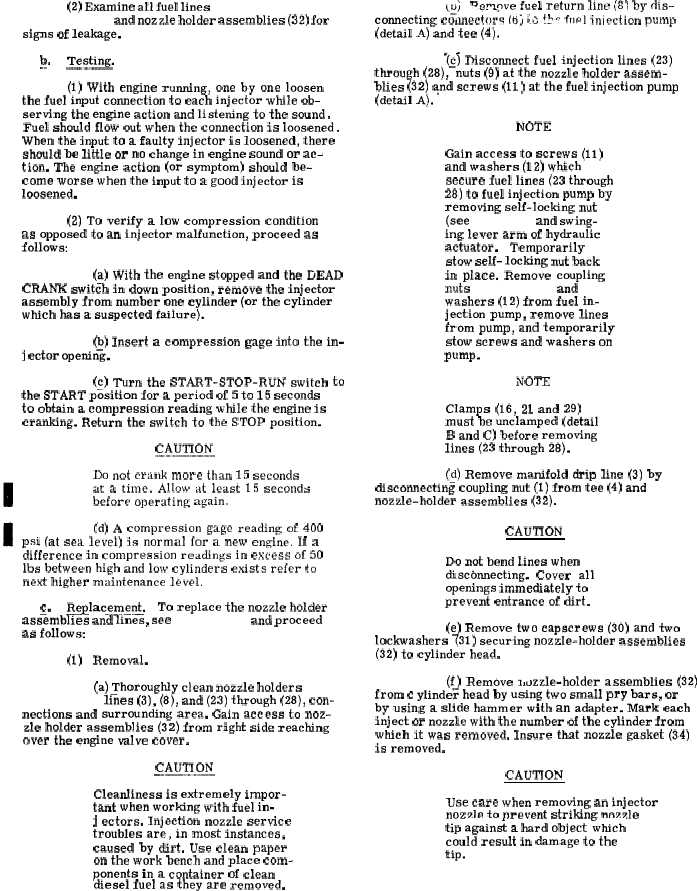(2) Examine all fuel lines ( 3 , 8 , a n d 2 3 t h r o u g h
2 8 , f i g . 3 - 4 1 ) and nozzle holder assemblies (32) for
signs of leakage.
b.
Testing.
.-
——
(1) With engine running, one by one loosen
the fuel input connection to each injector while ob-
serving the engine action and listening to the sound.
Fuel should flow out when the connection is loosened.
When the input to a faulty injector is loosened, there
should be little or no change in engine sound or ac-
tion. The engine action (or symptom) should be-
come worse when the input to a good injector is
loosened.
(2) To verify a low compression condition
as opposed to an injector malfunction, proceed as
follows:
(a) With the engine stopped and the DEAD
CRANK swit~h in down position, remove the injector
assembly from number one cylinder (or the cylinder
which has a suspected failure).
(b) Insert a compression gage into the in-
j ector openini.
(~) Turn the START-STOP-RUN switch
the START position for a period of 5 to 15 seconds
to obtain a compression reading while the engine is
cranking. Return the switch to the STOP position.
CAUTION
—..———
Do not crank more than 15 seconds
at a time. A11ow at least 15 seconds
before operating again.
(d) A compression gage reading of 400
psi (at sea level) is normal for a new engine. If a
difference in compression readings in excess of 50
lbs between high and low cylinders exists refer to
next higher maintenance level.
c.
Replacement.
To replace the nozzle holder
.-— ..— —
assZmbIf6s and lines, see f i g u r e 3 - 4 1 and proceed
as follows
(1)
Removal.
(a) Thoroughly clean nozzle holders
( 3 2
f i g .
3 - 4 1 ) , Ii=es (3), (8), and (23) through (28), con-
nections and surrounding area. Gain access to noz-
zle holder assemblies (32) from right side reaching
over the engine valve cover.
CAUTION
——.———
Cleanliness is extremely impor-
tant when working with fuel in-
j ectors. Injection nozzle service
troubles are, in most instances,
caused by dirt. Use clean paper
on the work bench and place com-
ponents in a container of clean
diesel fuel as they are removed.
3 - 9 8 C h a n g e 9
to
(:)
‘e.qnve fuel return line (8) by dis-
connecting connectors (ti) ;.C th~ fll~l iniection pump
(detail A) and tee (4).
(c) Disconnect fuel injection lines (23)
through (28),–nuts (9) at the nozzle holder assem-
blies (32) and screws (11 ) at the fuel injection pump
(detail A).
NOTE
Gain access to screws (11)
and washers (12) Which
secure fuel lines (23 through
28) to fuel injection pump by
removing self-locking nut
(see f i g . 3 - 3 2 ) and swing-
ing lever arm of hydraulic
actuator.
Temporarily
stow self- locking nut back
in place. Remove coupling
nuts ( 1 , f i g . 3 - 4 1 ) and
washers (12) from fuel in-
jection pump, remove lines
from pump, and temporarily
stow screws and washers on
pump.
LNOT E
Clamps (16, 21 and 29)
must be unclamped (detail
B and C) before removing
lines (23 through 28).
(d) Remove manifold drip line (3) by
disconnecting coupling nut (1) from tee (4) and
nozzle-holder assemblies (32).
CAUTION
Do not bend lines when
disconnecting.
Cover
all
openings immediately to
prevent entrance of dirt.
(e) Remove two capscrews (30) and two
Iockwashers 731) securing nozzle-holder assemblies
(32) to cylinder head.
(f) Remove ~,ozzle-holder assemblies (32)
from c ylinde~ head by using two small pry bars, or
by using a slide hammer with an adapter. Mark each
inject or nozzle with the number of the cylinder from
which it was removed. Insure that nozzle gasket (34)
is removed.
CAUTION
Use care when removing an injector
nozzle to tmevent striking nozzle
tip again~ a hard object &hich
could result in damage to the
tip.

